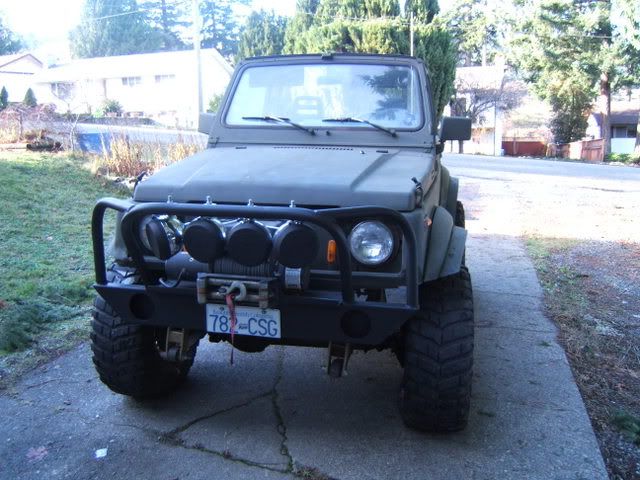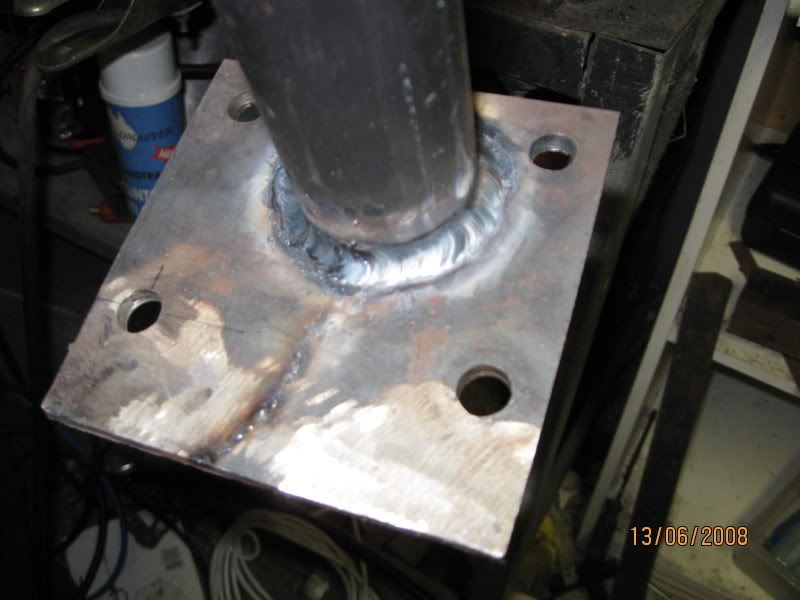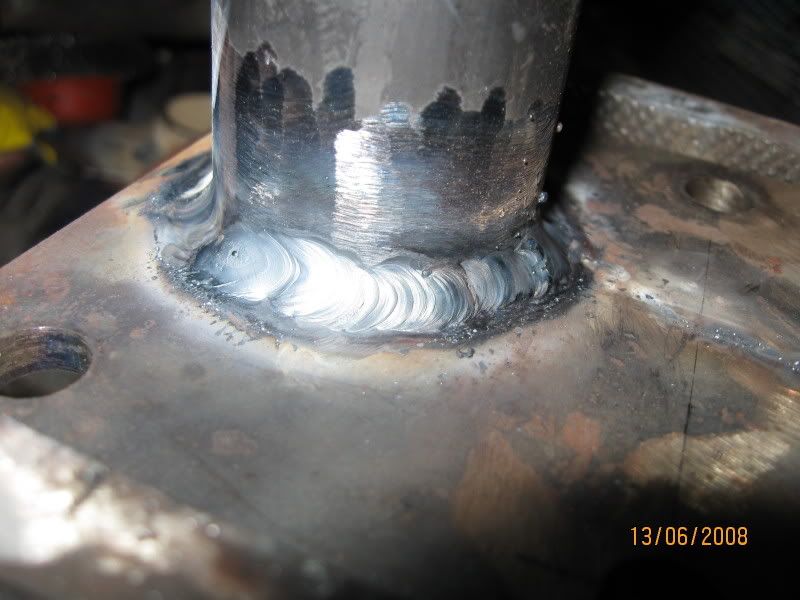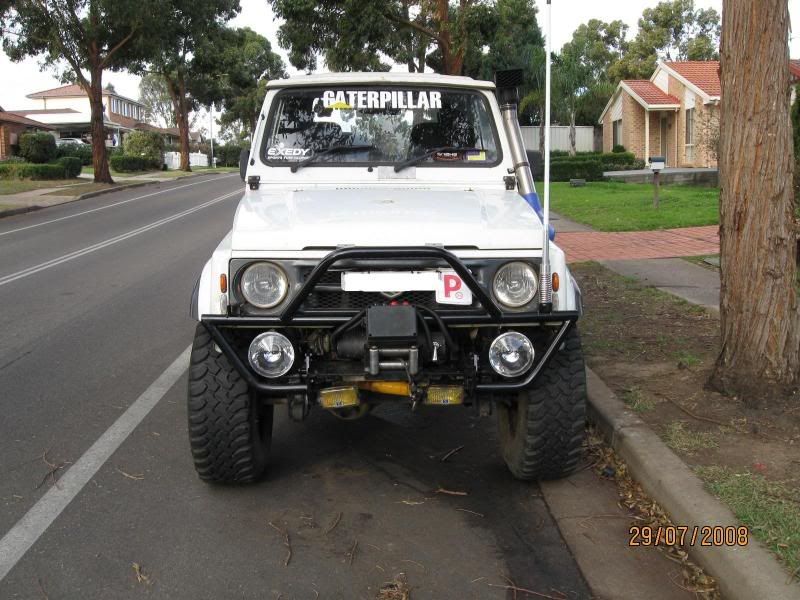You are using an out of date browser. It may not display this or other websites correctly.
You should upgrade or use an alternative browser.
You should upgrade or use an alternative browser.
making a bullbar some questions
- Thread starter brendan h
- Start date
- Messages
- 17,611
Al, the whole idea of this forum is to encourage diy welders to have a go, not discourage them. We were all learners once mate! 
Brendan's already said the winch won't be part of the structure so he now just wants to make a bullbar for protection so it will all be pretty much non-critical and well within the scope of a diyer.
Brendan, decide what material you want to make the bar out of and cut some pieces off to practice on, get used to preparing your joints and test your welds to destruction, you'll know if they're up to the job or not. I'd definitely recommend solid wire and argon/co2 gas though, it will give a much nicer appearance to your welds.
As they say, practice makes perfect .
.
Brendan's already said the winch won't be part of the structure so he now just wants to make a bullbar for protection so it will all be pretty much non-critical and well within the scope of a diyer.
Brendan, decide what material you want to make the bar out of and cut some pieces off to practice on, get used to preparing your joints and test your welds to destruction, you'll know if they're up to the job or not. I'd definitely recommend solid wire and argon/co2 gas though, it will give a much nicer appearance to your welds.
As they say, practice makes perfect
Ok, sorry if I sounded harsh. I was actually encouraging him to get stuck in with what he's got - hence the bits about using the mig and tacking it, or getting some practice and welding more of it himself. Just concerned about the safety aspect is all.
Brendan - no offense meant, just make sure its all nice and solid before you fire up the winch or give anyone a tow. Apologees if I sounded harsh. I'm no great welder myself - which is how come I have some ideas about how to get around it!
Cheers, Al.

Brendan - no offense meant, just make sure its all nice and solid before you fire up the winch or give anyone a tow. Apologees if I sounded harsh. I'm no great welder myself - which is how come I have some ideas about how to get around it!
Cheers, Al.

i can tig and i can stick. i know how to mig but havent realy done much. i have tiged a few bits of stainless for a bracket i made for my car. i just wanted info on what would be the best way to set it up. and i will be practacing on scrap bits of pipe to dial in my welds but i just need a starting point. i havent welded pipe befor and just want to know how to prepar it. i read that you bevel the ends so i might make up a braket for my bench grinder and use that. also how would i notch the pipe?
i have a unimig 172 set up for gasless at the moment. i have got an argoshild light bottle if i want to gas it.
also how would i do a destructive test? i dont have a press
i have a unimig 172 set up for gasless at the moment. i have got an argoshild light bottle if i want to gas it.
also how would i do a destructive test? i dont have a press
English Steve
Senior Bumpkin
- Messages
- 1,127
Beat it into submission with a hammer. If the weld breaks its a fail, if the parent metal breaks its a pass.
classic2cv
Member
- Messages
- 327
Hi again brendan
the mig you sounds like it's up to the job and you could use it in gasless mode for the time being
as for notching the pipe, you could always use a grinder to cut out the rough shape
then use a half round file to finnish
be sure you get a clouse fit and you'll be ok
you can practise the joins on some scrap bits
it's a good first prodject
if you look at the Tutorial section Link it even has a handy section on gasless welding
it will good when you've done it and if you welds are not perfect all that will happen is that it might fall to bits when you give it a good bash
you can always show it to a pro welder before you paint and see if you get the nod
go on give it a go and send us a photo when you fit onto you suzuki
the mig you sounds like it's up to the job and you could use it in gasless mode for the time being
as for notching the pipe, you could always use a grinder to cut out the rough shape
then use a half round file to finnish
be sure you get a clouse fit and you'll be ok
you can practise the joins on some scrap bits
it's a good first prodject
if you look at the Tutorial section Link it even has a handy section on gasless welding
it will good when you've done it and if you welds are not perfect all that will happen is that it might fall to bits when you give it a good bash
you can always show it to a pro welder before you paint and see if you get the nod
go on give it a go and send us a photo when you fit onto you suzuki

storm monkey
Cluless Expert!
- Messages
- 210
Another good plan for checking you weld quality is to prepare a test joint, weld it up, then cut it up, so you can inspect the weld section. That way you'll be able to look at the back of the weld, to check penetration, and a slightly polished up section will help to show how much fusion you have in each tube part.
We do this all the time at work (earth moving machine chassis structures) and it is a very useful tool.
Phil
We do this all the time at work (earth moving machine chassis structures) and it is a very useful tool.
Phil
For notching the pipe you can also just use a chopsaw.
The following was taken from Pirate4x4 and it's wat I use.
The chop saw method,if understood , is a science. With known tube size and joint angle, tube can be notched with great accuracy. The notch is acheved by cutting two opposing angles on one end of a peice of tube, to form a point. The cross-section of this cut will be an elipitical cut due to the shape of the tube. Changes in boath of the two angled cuts must be made for the intersection angle and the size of the two tubes being joined. The only real limitation is the max angle of the chop saw.
You start with what I call the base angle. This is the angle of boath cuts if the joint was 90*. For an example, I am fitting Two tubes together that are boath 1.75", at an 90* joint. The base angle, or the angle of boath cuts is 28*. These two cuts must meet at a point, and the point must allso be centered on the tube.
What if I want an 15* joint with my 1.75" tube???? You must start with your base angle, witch was 28* for 1.75"(remember above), and subtract 15* from one cut, and add 15* to the other cut to form a perfect notch. So now I must make a 13* cut and an 43* cut , with the point centered on the tube. Perfect coped joint, with no grinding.
Remember your base angle will change with the tube being cut and the tube that you are fitting to.
Here are a few examples of base angles...
2.0" to 2.0" tube, base angle of 30*
1.75" to 1.75" tube, base angle of 28*
1.5" to 1.5" tube, base angle of 26*
1.25" to 1.25" tube, base angle of 22.5*
1" to 1" tube, Base angle of 20*
Now to fit diffrent size tubes together
1.75" to 2" tube, base angle of 25*
1.75" to 1.25" tube, base angle of 45*
1.25" to 1.75 tube, base angle of 20*
1" to 2" tube, base angle of 12*
Here's the bumper I did using the above method and a 110v lincoln and .035 flux core.

I hope that helps
The following was taken from Pirate4x4 and it's wat I use.
The chop saw method,if understood , is a science. With known tube size and joint angle, tube can be notched with great accuracy. The notch is acheved by cutting two opposing angles on one end of a peice of tube, to form a point. The cross-section of this cut will be an elipitical cut due to the shape of the tube. Changes in boath of the two angled cuts must be made for the intersection angle and the size of the two tubes being joined. The only real limitation is the max angle of the chop saw.
You start with what I call the base angle. This is the angle of boath cuts if the joint was 90*. For an example, I am fitting Two tubes together that are boath 1.75", at an 90* joint. The base angle, or the angle of boath cuts is 28*. These two cuts must meet at a point, and the point must allso be centered on the tube.
What if I want an 15* joint with my 1.75" tube???? You must start with your base angle, witch was 28* for 1.75"(remember above), and subtract 15* from one cut, and add 15* to the other cut to form a perfect notch. So now I must make a 13* cut and an 43* cut , with the point centered on the tube. Perfect coped joint, with no grinding.
Remember your base angle will change with the tube being cut and the tube that you are fitting to.
Here are a few examples of base angles...
2.0" to 2.0" tube, base angle of 30*
1.75" to 1.75" tube, base angle of 28*
1.5" to 1.5" tube, base angle of 26*
1.25" to 1.25" tube, base angle of 22.5*
1" to 1" tube, Base angle of 20*
Now to fit diffrent size tubes together
1.75" to 2" tube, base angle of 25*
1.75" to 1.25" tube, base angle of 45*
1.25" to 1.75 tube, base angle of 20*
1" to 2" tube, base angle of 12*
Here's the bumper I did using the above method and a 110v lincoln and .035 flux core.

I hope that helps
Weldingartisan
Aiming for retirement
- Messages
- 533
brendan h,
If you can MMA (stick weld), leave the MIG under the bench and and use the stick set! It is quite easy to lay down a good looking MIG weld with no fusion whatsoever but a good looking MMA weld will nearly always have good fusion.
To test a butt weld, cut out a 'coupon' (15mm wide strip) from welded plates/pipe leaving the weld across the centre of coupon aprox 100mm long, file off any weld reinforcement (cap) to the plate thickness and reverse bend (root outwards) over a 15mm former. The former is just a 50mm long 15mm diameter rod welded to a short piece of bar so it can be clamped with the test coupon in the vise. It should bend 90 deg without showing any cracks. W/A
If you can MMA (stick weld), leave the MIG under the bench and and use the stick set! It is quite easy to lay down a good looking MIG weld with no fusion whatsoever but a good looking MMA weld will nearly always have good fusion.
To test a butt weld, cut out a 'coupon' (15mm wide strip) from welded plates/pipe leaving the weld across the centre of coupon aprox 100mm long, file off any weld reinforcement (cap) to the plate thickness and reverse bend (root outwards) over a 15mm former. The former is just a 50mm long 15mm diameter rod welded to a short piece of bar so it can be clamped with the test coupon in the vise. It should bend 90 deg without showing any cracks. W/A
well i decided to TIG it. i tacked it with MMA. got some under cut but dont know why. i was using 200amps and a 2.4mm filler. pipe was a mix of 3.2 and 4.2 wall i think, close enough
if i had to do it again i probably would have used MMA and some 6011 rod for the first run to get it to penetrate
anyway some pics of the welds




and painted

if i had to do it again i probably would have used MMA and some 6011 rod for the first run to get it to penetrate
anyway some pics of the welds




and painted

Weldingartisan
Aiming for retirement
- Messages
- 533
Should be nearer 100amps for tacking a fillet with 2.5mm 6013's, hence the undercut. Still turned out OK though eh. W/A
Weldingartisan
Aiming for retirement
- Messages
- 533
No, I can't see the tacks! I was commenting on what you said. W/A
- Messages
- 6,343
well i decided to TIG it. i tacked it with MMA. got some under cut but dont know why. i was using 200amps and a 2.4mm filler.
[]
you've just answered your own question there....
- Messages
- 6,343
so too many amp cause the undercut?
what sort of amp should i have used?
you would have probably got away with nearly half that, although it does depend on the welders preference and technique, size of joint fitments prep, the list goes on, but a good way of getting a good feel for amps is to weld a few coupons (small scrap pieces of material) and do a few destruction tests.





